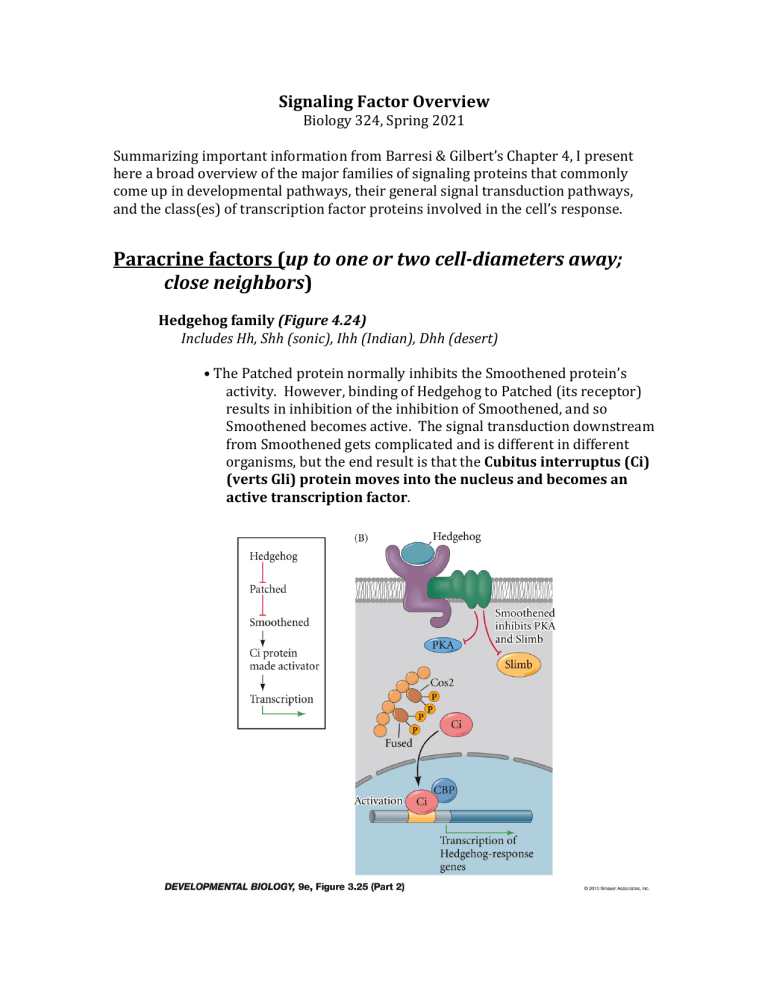
Signaling Factor Overview Biology 324, Spring 2021 Summarizing important information from Barresi & Gilbert’s Chapter 4, I present here a broad overview of the major families of signaling proteins that commonly come up in developmental pathways, their general signal transduction pathways, and the class(es) of transcription factor proteins involved in the cell’s response. Paracrine factors (up to one or two cell-diameters away; close neighbors) Hedgehog family (Figure 4.24) Includes Hh, Shh (sonic), Ihh (Indian), Dhh (desert) • The Patched protein normally inhibits the Smoothened protein’s activity. However, binding of Hedgehog to Patched (its receptor) results in inhibition of the inhibition of Smoothened, and so Smoothened becomes active. The signal transduction downstream from Smoothened gets complicated and is different in different organisms, but the end result is that the Cubitus interruptus (Ci) (verts Gli) protein moves into the nucleus and becomes an active transcription factor. Receptor Tyrosine Kinases (RTK) (Figure 4.20) Platelet Derived Growth Factor (PDGF) Family Fibroblast Growth Factor (FGF) Family • FGFs / PDGFs bind to trans-membrane receptors that have tyrosine kinase activity on their cytoplasmic side. Ligand binding activates the receptors’ kinase activity. The receptors then activate Ras proteins on the cytoplasmic side of the plasma membrane, and then a cascade of cytoplasmic serine/threonine kinases functions to activate a variety of transcription factors, including those of the Elk family. Wnt family (Figure 4.28) Includes Wnt and Wg(wingless) • Wnt binds to its receptor Frizzled, and this activates the Disheveled protein. Activated Disheveled inhibits the GSK-3 kinase, and this allows the b-catenin protein to move into the nucleus and become an activating transcription factor. Let’s also just note here that Wnt is a wild and crazy paracrine factor and its binding to Frizzled can also affect the cytoskeleton and intracellular Ca++ levels. Transforming Growth Factor Beta family (Figure 4.30) Includes TGF-bs, Activins, Bone Morphogenic proteins (BMPs), Vg1, Nodal, Dpp • TGF-b binds to two types of trans-membrane receptors, Type I and Type II, forming a hetero-dimer. The Type I receptor has serine/threonine kinase activity on its cytoplasmic side, and it phosphorylates the Type II receptor. That phosphorylation activates the Type II receptor’s kinase activity and it then phosphorylates various Smad proteins in the cytoplasm (for example Activin triggers Smad2 and 3 phosphorylation; BMP triggers Smad1 and 5 phosphorylation). Different phosphorylated Smads dimerize with Smad4, move into the nucleus and form both activating and repressing transcription factors. Juxtracrine factors (requires cell:cell contact) Notch, Delta/Serrate/LAG-2 (DSL) Family (Figure 4.37) Both Delta and Serrate are trans-membrane proteins • Either Delta or Serrate binds to Notch, a trans-membrane protein on an adjacent cell. This activates a Notch-specific protease in the cell expressing Notch that snips off part of Notch’s intracellular tail (NICD; Notch Intracellular Domain). The NICD then moves to the nucleus and acts as an activating transcription factor.
